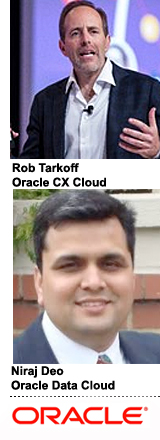
Oracle kicked off its OpenWorld conference Monday by introducing a customer data platform (CDP) to connect disparate data sources and a subscription management product to capitalize on the blossoming subscription economy.
The CDP, CX Unity, is now pre-integrated with the Oracle Customer Experience (UX) Cloud and is designed to tie marketers’ first-party data to anonymous third-party offline and online data.
“You can think of this as a next-gen CDP in many ways because it connects not only third-party and first-party data, but it is a profile and customer intelligence service that will be delivered throughout the customer journey and consumed by the Oracle CX applications,” Rob Tarkoff, EVP and GM of CX Cloud, told AdExchanger.
Connecting the clouds
The CX Cloud encompasses Oracle’s front-office clouds covering the customer journey from sales, service and marketing to commerce. Oracle offers third-party data via Oracle Data Cloud but will allow CX Unity users to use any third-party data source.
Oracle wants to enable CX Unity to work with whatever products Oracle’s customers are using. Its Marketing and Data Cloud products ingest data from other sources and send data to other platforms, such as Salesforce. Oracle said CX Unity supports GDPR requirements out of the gate but didn’t go into more detail.
Tarkoff said CX Unity gives marketers a real-time, continuous and contextual view of the customer journey. The CDP can, for instance, pull information about a customer’s outstanding service requests to modify messaging on the fly. Or a marketer can understand customer clickstream activity during their most recent shopping cart experience.
Machine learning and artificial intelligence are built into each cloud application – known as Adaptive Intelligence Apps – which sits on top of the CX Unity layer.
“You’ll be able to, on the fly, bring together customer data from service, sales, commerce and marketing, apply Oracle’s built-in machine learning and be able to deliver optimal experiences in the context of the app,” Tarkoff said.
Subscription economy
Oracle is also going after the burgeoning subscription economy with its new Subscription Management product. It can serve both startup direct-to-consumer business models and legacy physical goods companies that are reimagining ownership of their products beyond the one-time outright ownership model.
For example, a hospital may create a subscription model to share MRI machines across different facilities, rather than buying a machine individually.
“[Subscription Management] includes configuring a subscription in the front end, putting in place the intelligence to optimize the value of a business or a consumer, and then connecting into the billing and financial ERP infrastructure on the back end,” Tarkoff said.
Moving to a more flexible use and recurring relationship model means companies must learn how to market it and provide opportunities for customers to sign up and configure subscriptions.
“This is a huge opportunity for digital marketers to move themselves from promotional campaign tacticians to really getting into the middle of revenue generation because subscription end-to-end – because it’s a recurring model – has more digital touch points, and those are typically owned by the marketer,” Tarkoff said.
He sees it as one of the largest potential role expansions of the digital marketer inside companies.
“Digital marketing used to be just the domain of customer acquisition, segmentation and thinking about it as an upper-funnel activity,” Tarkoff said. “Now that so much more of the touch points are along the journey where products and services are being renewed via subscription, add-ons are being purchased and subscriptions are being reconfigured, so there is this living, breathing recurring asset relationship between a customer and company, particularly in a physical goods market, that didn’t use to exist.”
‘ABM for SMBs’
Also on Monday, Oracle Data Cloud launched an SMB solution to help B2B marketers find and target small businesses.
Oracle revamped its small business data taxonomy, for example, to help B2B marketers like banks and financial institutions find small businesses that are growing, in good credit standing or engaged in foreign exchanges.
Oracle also improved its matching capabilities to help B2B marketers find small businesses that aren’t linked to websites or company emails. Now B2B marketers can match small businesses by name, rather than email addresses, and the information is brought into the Data Cloud ID graph.
“The ABM (account-based marketing) that was designed earlier was for managing large accounts, but you don’t have to be restricted to that,” Niraj Deo, VP for product and data strategy for Oracle Data Cloud, told AdExchanger. “What we are enabling is ABM for SMBs.”
This post was syndicated from Ad Exchanger.


More Stories
M+AD takes break for Anzac Day commemoration
Sustainability Is More Than a Big Leafy Green Picture
Google Won’t Pull Cookies In 2024